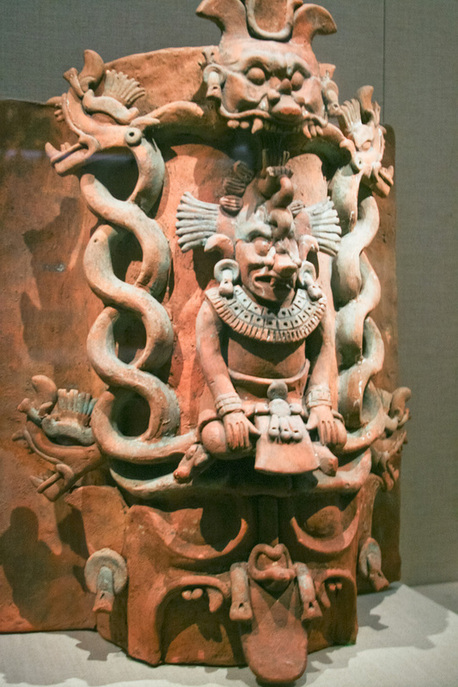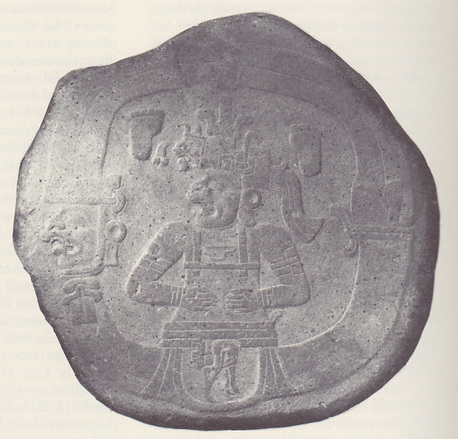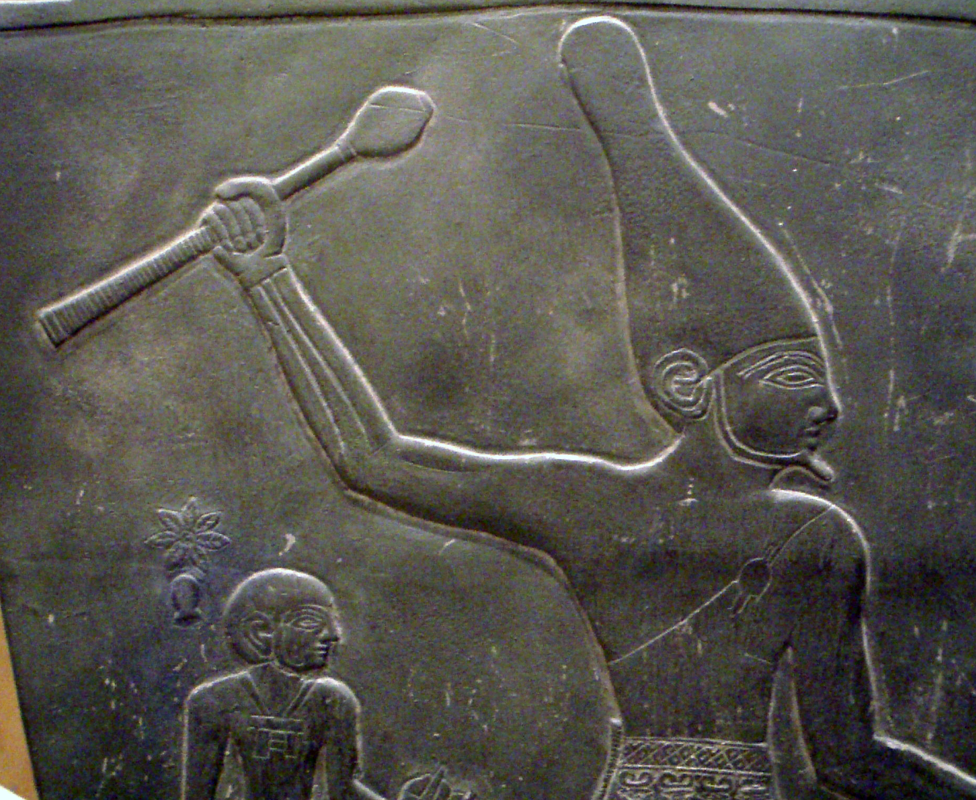Mars
|
c -4219 - -3147
Mars's northern hemisphere is marked with eight gigantic electrical blisters (named "mons" or "tholus"), but no "meteor impacts." The blisters are the result of sustained lightning strikes. [...] The largest blister, Olympus Mons (three times as high as the Himalayas), shows some five separate melting pools. #(Cook, Appendix A) The coincidence of "eight kings" and "eight blisters" is striking, but is likely enough to be coincidence. That these anode blisters were delivered by Mercury's "grinding of the maize-meal" between c. -4219 and -3147 is altogether possible. The name for Mars listed in the Chilam Balam, "Bolon Dzacab," means "nine appearances." (Cook Appendix A) The reference to the eight "kings before the flood" is the description of the ascension of Nine-Lives (Bolon Dzacab). He is known as Nine-Lives, I would suspect, because he ascends nine times and was seen closer to Saturn than Earth nine times. Mesoamerican languages emphasize the completion of actions rather than the start. (The action was to leave behind a mountain of maize mush.) Similarly, Nine-Lives is only mentioned once since repetitions of the activity are not needed in a book of prophesies. Nine-Lives is known to be Mars. He is called "this first Bolon Dzacab," very similar to Egyptian naming of the early Horus (during the "Era of the Gods") as "Horus of the Gods." These suggest that Mars may have changed its looks after -3147. (Cook, Appendix A) -- When, after 80 years of "negotiations" near the glowing "river" of the asteroid belt, Mars and Mercury returned, suddenly visible near the ecliptic. The Pharaoh figure on the 'Narmer Palette' may be identified as Mars by the 'White Crown' on his head.
Mars would have been much closer to Earth at this point than during most of the Saturnian 'Golden Age.' This seems to be suggested from the Sumerian 'King List,' where the last descent to Earth of Mars was only 80 years prior to c. -3147, much less than the average of 141 years of the previous seven "reigns." "The White (and Red Crown) of Egypt depict Mars in the stream of a plasma connection in glow mode from Saturn, probably at a late date in the "Era of the Gods" -- after Saturn had ceased its initial nova condition in arc mode. The White Crown shows the plasma stream frontally lighted by the Sun and thus hiding Mars. The Red Crown shows the same stream at night, back lighted by the Sun (and casting a partial shadow) with the red surface of Mars showing through the plasma stream. If we assume that the White or Red Crown of Egypt represents approximately the size of a human head and seen at arm's length (which is, of course, very subjective), then it might have subtended about 2.5 to 3.0 degrees (the angle subtended by a hand at arm's length). On the basis of the above conjecture, it could be suggested that the upper bulb of the White Crown, representing Saturn, would be about 1.5 degrees wide visually (half the width of the larger Horus bulb). That clearly places Saturn 2.8 million miles from Earth. 72000 * (cos (1.5) / sin (1.5)) = 2.75 million miles The same reasoning, applied to Mars in its lowered position, reveals a distance of about 80,000 miles between Earth and Mars at the closest approach: arctangent (4200/80000) = 3.0 degrees. " |
"Mars . . . in violent discharge from Saturn at least since the Gravettian, 40,000 years ago . . . ."#(Cook, Appendix B n.8)
Gravettian Era figurines, c. -28,000 to -24,000, seem to indicate Mars was visibly part of the Saturnian Polar Stack during that era. c. -4939 Incipit reign of pre-nova King Alorus (appearance of Mars/Mercury in the North Skies, as seen "seated" on the 'throne' of Saturn). Mercury, as 'Xmucane,' begins 'grinding corn-meal' 0 Alorus 720 y 4939 - 4220 BC c. -4219 First 'descent' of Mars (King List) "[T]o take a long time for Mars to slowly recede from Saturn would be expected. That the lowering of Mars was the result of an angled orbit is unlikely, for in that event Mars would have lowered a thousand times. Even the Vedas do not suggest "a thousand times," but propose that Mars lowered "100 times," where "100 times" likely means "frequently." #(Cook, Appendix A) First appearance of 'cornmeal mountain;' Mercury as 'Xmucane' begins 'grinding maize-meal' a 2nd time 1 Alulim 128 4219 - 4092 BC -4077 Beginning of creation as the birth of Adam, 930 years before -3147. Possibly an estimate related to the end of Alulim's reign in -4092? 2 Alaljar 160 4091 - 3932 BC Mercury as 'Xmucane' begins 'grinding maize-meal' a 3rd time -3944 Creation date per Massoretic Bible (based on calculation of 1948 yrs from Abram back to Adam). Possibly an estimate related to the end of Alaljar's reign in -3932? 3 Enmenluana 192 3931 - 3740 BC Mercury as 'Xmucane' begins 'grinding maize-meal' a 4rd time 4 Enmengalana 128 3739 - 3612 BC Mercury as 'Xmucane' begins 'grinding maize-meal' a 5th time 5 Dumuzid 160 3611 - 3451 BC Mercury as 'Xmucane' begins 'grinding maize-meal' a 6th time 6 Ensipadzidana 128 3450 - 3323 BC Mercury as 'Xmucane' begins 'grinding maize-meal' a 7th time 7 Ermendurana 96 3322 - 3227 BC Mercury as 'Xmucane' begins 'grinding maize-meal' - 8th time 8 UbaraTutu 80 3226 - 3147 BC Mercury as 'Xmucane' seen to continue 'grinding maize-meal' for the 9th time, tho 'cornmeal moutain' has disappeared c. -3147 to -3067 Mars may likely have been "at a potential partially equal to that of Saturn's plasmasphere," and thus remained within Saturn's plasmasphere (with Mercury) until being released c. -3067, when Saturn encountered the asteroid belt and its plasmasphere shrank to the point of excluding its lower axial appendage. Together, the relatively small dependent column of Mercury and Mars may have been the visual origin of the mytho-historical 'missing penis' of Osiris. c. -3067 Most likely first regular appearance of Mercury-Mars/Horus; inferred to have happened 10 times by Egyptian records, some 10 or 11 times by the Kings List, 10 times by the Maya Chilam Balam (from c. -3067 to -2750 to -2700) c. -806 to -687 Mars passed by the Earth at a distance of perhaps 40,000 miles -- well within Earth's plasmasphere. No shock would have been experienced then, only a continuous arc of lightning. (This is a rare case of 2 planets in relatively close proximity, and seems to have been so traumatic that "unconscious" archetypal imprints stirred to awakening briefly in the panicking public who tuned in to Orson Welles' radio drama "War of the Worlds" in October 1938.) |


